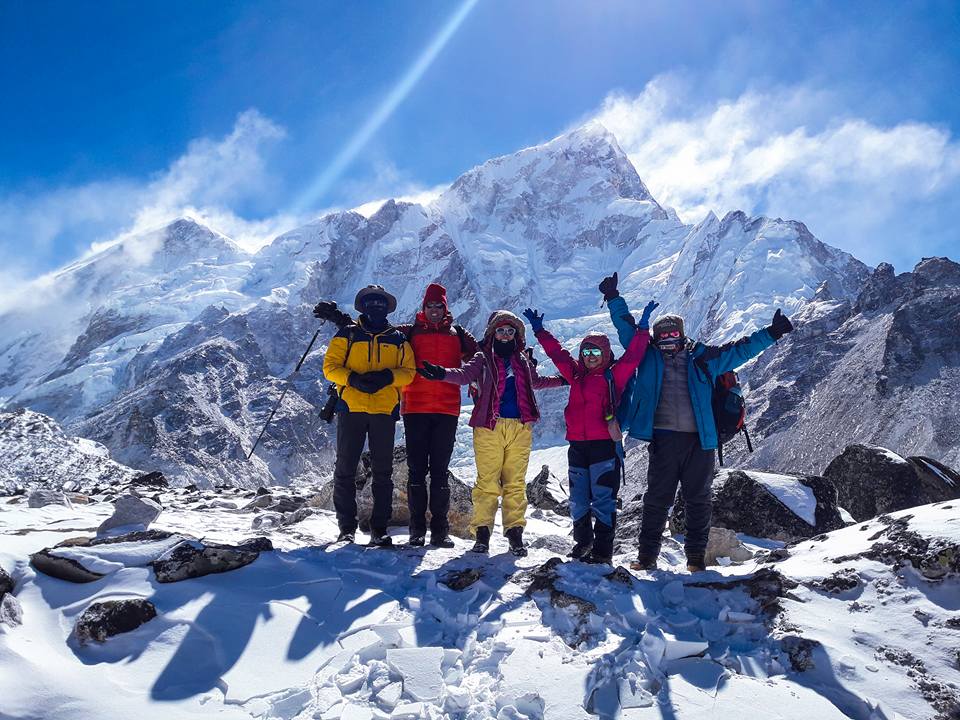Everest Base Camp Trek highlights
The Everest Base Camp Trek stands as one of the most iconic and rewarding trekking experiences in the world, celebrated for its unparalleled natural beauty, cultural richness, and the sheer sense of adventure it offers. The trek, set against the backdrop of the world’s highest peak, Mount Everest, unfolds a series of breathtaking highlights that captivate trekkers from start to finish.
One of the most memorable aspects of the trek is the dramatic journey through the Khumbu region, which begins with the thrilling flight into Lukla. Known for its precarious runway and stunning approach, Lukla sets the stage for an adventure that quickly reveals the grandeur of the Himalayas. From Lukla, trekkers traverse lush forests, terraced fields, and quaint Sherpa villages, each offering a glimpse into the vibrant culture and daily life of the Khumbu inhabitants.
Namche Bazaar, a bustling market town nestled in a bowl-shaped valley, is a significant highlight. At an elevation of 3,440 meters (11,286 feet), Namche serves as a vital acclimatization point and provides stunning panoramic views of the surrounding peaks, including Everest, Lhotse, and Ama Dablam. The town’s vibrant atmosphere, with its colorful market and friendly locals, adds to the trek’s cultural richness.
Continuing the journey, Tengboche offers a unique highlight with its famous monastery, perched at 3,860 meters (12,664 feet). The monastery, surrounded by majestic peaks, provides trekkers with spiritual insights and a peaceful retreat. The views from Tengboche are awe-inspiring, showcasing some of the most breathtaking panoramas of the Himalayas.
Dingboche, situated at 4,410 meters (14,470 feet), stands out as another key highlight. Known for its high-altitude terrain and stunning vistas, Dingboche is a crucial acclimatization stop. The valley, surrounded by towering peaks, offers an extraordinary setting for acclimatization and preparation for the final ascent.
The trek’s culminating highlight is reaching Everest Base Camp at 5,364 meters (17,598 feet). Standing at the foot of Mount Everest, trekkers are rewarded with an extraordinary view of the world’s highest peak and its surrounding glacier fields. The sense of accomplishment and the sheer scale of the surrounding peaks create an unforgettable experience.
The return journey retraces the route, allowing trekkers to revisit and reflect on the highlights of their adventure. The Everest Base Camp Trek is not just about reaching a destination; it is a profound journey through one of the most breathtaking and culturally rich regions on Earth, marked by incredible landscapes, cultural encounters, and personal achievement.
Introduction to Everest Base Camp Trek
The Everest Base Camp Trek is a renowned adventure that draws trekkers from around the globe to the foothills of Mount Everest, the world’s highest peak. This iconic trek, typically spanning 12 to 14 days, offers a unique blend of natural beauty, cultural immersion, and physical challenge. Starting from the bustling town of Lukla, trekkers traverse through the Khumbu region, ascending gradually to reach Everest Base Camp at an elevation of 5,364 meters (17,598 feet). The trek’s popularity stems from the unparalleled views of the Himalayas, the opportunity to experience Sherpa culture firsthand, and the profound sense of achievement that comes from standing at the base of Everest. The journey involves crossing suspension bridges, trekking through dense forests, and navigating rugged terrain, all while adapting to the increasing altitude. Key highlights include vibrant mountain villages, scenic viewpoints, and significant cultural landmarks. This trek is not just a physical challenge but a deeply rewarding experience that combines adventure with cultural exploration, making it a bucket-list journey for many.
Scenic Views of the Himalayas
The Everest Base Camp Trek is renowned for its breathtaking scenic views of the Himalayas, providing trekkers with some of the most spectacular mountain vistas in the world. From the moment the trek begins, the majestic peaks of the Khumbu region dominate the landscape, offering ever-changing panoramas that captivate and inspire. As trekkers ascend, they are treated to sweeping views of Everest, Lhotse, and Nuptse, along with other towering peaks like Ama Dablam and Makalu. The trek passes through various vantage points, including the renowned Namche Bazaar, where panoramic views of the surrounding mountains create an awe-inspiring backdrop. Tengboche provides another dramatic viewpoint, with its monastery set against the towering peaks of Everest and Ama Dablam. The final approach to Everest Base Camp itself offers a dramatic close-up of Everest’s south face, surrounded by the massive Khumbu Glacier. Each stage of the trek unveils new and stunning perspectives of the Himalayas, making the journey a visual feast for nature lovers and adventure enthusiasts alike.
Culture and Heritage of the Sherpa People
The Everest Base Camp Trek Weather provides a profound opportunity to immerse oneself in the rich culture and heritage of the Sherpa people, who are an integral part of the Khumbu region. Sherpas are renowned for their mountaineering skills and deep-rooted connection to the mountains. Along the trek, visitors encounter traditional Sherpa villages such as Namche Bazaar, where vibrant markets and traditional architecture showcase their cultural heritage. The Sherpas practice Tibetan Buddhism, and their culture is infused with spiritual significance, reflected in their daily lives, rituals, and festivals. Trekkers have the chance to engage with local Sherpas, learn about their customs, and appreciate their hospitality. The trek also includes visits to monasteries and stupas, which are central to Sherpa religious life. The Sherpas’ enduring traditions and their deep respect for the natural environment add a unique cultural dimension to the trek, making it a journey not only through spectacular landscapes but also into the heart of a fascinating and resilient culture.
Visit to Tengboche Monastery
A visit to Tengboche Monastery is one of the highlights of the Everest Base Camp Trek, offering both spiritual and scenic rewards. Located at 3,860 meters (12,664 feet), Tengboche Monastery is one of the most significant and revered Buddhist monasteries in the Khumbu region. The monastery is renowned for its stunning location, perched on a ridge with panoramic views of Mount Everest, Ama Dablam, and other towering peaks. The spiritual ambiance of the monastery, combined with its spectacular setting, provides trekkers with a moment of reflection and tranquility amidst the challenging trek. Visitors often have the opportunity to witness traditional Buddhist ceremonies, such as prayer rituals and chanting, which offer insights into Sherpa spiritual practices. The monastery also serves as a cultural hub, where trekkers can learn about local religious traditions and engage with the monks. The serene environment and breathtaking vistas make Tengboche Monastery a memorable and enriching part of the Everest Base Camp Trek, adding a spiritual dimension to the adventure.
Diverse Flora and Fauna
The Everest Base Camp Trek is not only a journey through dramatic landscapes but also an exploration of diverse flora and fauna. As trekkers ascend from the lush lower altitudes to the higher, more rugged terrain, the changing environment supports a wide range of plant and animal life. In the lower elevations, such as the lush forests around Lukla and Phakding, trekkers encounter vibrant rhododendron forests, pine trees, and a variety of wildflowers. As the trek progresses, the vegetation becomes sparser, with alpine shrubs and hardy grasses dominating the landscape. The region is also home to a range of wildlife, including the elusive snow leopard, Himalayan tahr, and various species of pheasants and eagles. The trek through the Sagarmatha National Park, a UNESCO World Heritage site, provides opportunities to spot rare and endangered species, contributing to the trek’s appeal for nature enthusiasts. The diverse flora and fauna of the Everest Base Camp Trek add an extra layer of fascination to the adventure, showcasing the rich natural heritage of the Himalayas.
Exploring Namche Bazaar
Namche Bazaar, situated at 3,440 meters (11,286 feet), is a vibrant and bustling hub in the Khumbu region, offering a blend of cultural richness and stunning natural beauty. As the gateway to Everest Base Camp, Namche Bazaar serves as a crucial acclimatization stop for trekkers, providing a chance to adjust to the altitude before continuing higher. The town itself is nestled in a natural bowl-shaped valley, surrounded by towering peaks like Mount Everest, Lhotse, and Ama Dablam, creating a breathtaking backdrop for visitors. Namche Bazaar is renowned for its colorful markets, where trekkers can shop for local handicrafts, gear, and supplies, and enjoy traditional Sherpa cuisine. The town also hosts various cultural attractions, including the Sherpa Museum, which offers insights into the region’s history, culture, and mountaineering heritage. The vibrant atmosphere, with its lively shops, cafes, and stunning mountain views, makes Namche Bazaar a memorable and essential part of the Everest Base Camp Trek.
Khumbu Glacier Experience
The Khumbu Glacier, one of the largest glaciers in the Himalayas, is a striking feature of the Everest Base Camp Trek. Stretching for miles, this massive glacier provides an awe-inspiring and stark landscape, characterized by its icy blue crevasses, towering ice seracs, and rugged terrain. Trekking along the glacier, especially on the approach to Everest Base Camp, offers trekkers a close-up view of this dynamic and dramatic ice formation. The glacier is fed by the snow and ice from the surrounding peaks, including Mount Everest, and its immense size and changing surface make it a continually evolving landscape. The walk along the glacier’s moraine, where the ice meets the rocky terrain, provides a unique and surreal experience, showcasing the raw power of nature. Observing the glacier’s features and understanding its role in the Everest region’s ecosystem adds a fascinating dimension to the trek, making the Khumbu Glacier a highlight for those exploring the base camp.
Kala Patthar – The Best Viewpoint
Kala Patthar, standing at 5,545 meters (18,192 feet), is renowned as the premier viewpoint on the Everest Base Camp Trek, offering unparalleled panoramic vistas of Mount Everest and the surrounding peaks. The climb to Kala Patthar is a challenging but rewarding ascent, typically undertaken in the early morning to catch the sunrise over the Himalayas. From the summit, trekkers are treated to a breathtaking view of Everest’s south face, along with stunning perspectives of neighboring peaks such as Lhotse, Nuptse, and Pumori. The clear, crisp mountain air and the early morning light create an unforgettable visual experience, making Kala Patthar a must-visit for those seeking the ultimate panoramic view of the Everest region. The vantage point also provides an opportunity to reflect on the journey and the magnificent landscapes encountered along the trek. The stunning views from Kala Patthar serve as a fitting climax to the adventure, offering a memorable and exhilarating conclusion to the trek.
Unique Teahouse Accommodations
Teahouse accommodations along the Everest Base Camp Trek provide a distinctive and integral aspect of the trekking experience. These simple, yet comfortable lodgings are typically run by local Sherpas and offer a cozy retreat after a day of trekking. Teahouses are more than just places to sleep; they serve as social hubs where trekkers can interact with fellow adventurers and experience local hospitality. The rooms are generally basic, with twin beds, and shared bathrooms, but they provide essential amenities and a warm, welcoming environment. The communal dining areas offer traditional Sherpa meals, including dishes like dal bhat (rice and lentils), and provide a space for trekkers to relax and share stories. Staying in teahouses also contributes to the local economy and fosters a deeper connection with the region’s culture. The experience of sleeping in these quaint lodgings, nestled in the heart of the Himalayas, adds a unique and personal touch to the trekking adventure, making it an integral part of the Everest Base Camp journey.
Stunning Sagarmatha National Park Landscapes
Sagarmatha National Park, a UNESCO World Heritage site, is renowned for its stunning and diverse landscapes, which form a significant part of the Everest Base Camp Trek. The park encompasses a vast area of the Himalayas, including the iconic Mount Everest, Lhotse, and other towering peaks. Trekkers traverse through varied terrain, from lush forests and alpine meadows to rugged, high-altitude regions. The park’s landscapes are characterized by dramatic features such as deep valleys, swift rivers, and vast glacier fields, creating a continually changing panorama. The dramatic contrasts in scenery—from the dense, vibrant rhododendron forests of lower altitudes to the stark, icy expanses of the higher elevations—highlight the region’s ecological diversity. The natural beauty of Sagarmatha National Park, combined with its rich biodiversity and the impressive scale of its mountain vistas, enhances the trekking experience, making it not only a physical challenge but also a journey through one of the most spectacular natural environments on the planet.
Interaction with Local Communities
Interaction with local communities is a deeply enriching aspect of the EBC Trekking, offering trekkers a unique opportunity to immerse themselves in the vibrant culture of the Khumbu region. Throughout the trek, adventurers encounter the Sherpa people, whose hospitality and traditional way of life are integral to the region. Villages like Namche Bazaar and Tengboche provide a chance to engage with locals, learn about their customs, and witness their daily routines. Visitors often share stories with Sherpas in teahouses, participate in cultural exchanges, and gain insights into their Buddhist traditions. The trek also includes visits to local markets and festivals, where trekkers can observe and participate in traditional activities. This interaction fosters mutual respect and understanding, creating memorable experiences and a deeper connection to the region. Engaging with the Sherpa community not only enriches the trekking experience but also supports the local economy and helps preserve the cultural heritage of the Everest region.
Trekking Challenges and Achievements
The Everest Base Camp Trek is renowned for its physical and mental challenges, which make the journey a significant achievement for trekkers. One of the primary challenges is the high altitude, which demands careful acclimatization to prevent altitude sickness and ensure a successful ascent. The trek involves several steep ascents and descents, with varying weather conditions adding to the difficulty. Trekkers must navigate rugged terrain, including rocky paths and icy stretches, requiring endurance and perseverance. Despite these challenges, the trek offers profound rewards, including the sense of accomplishment that comes with reaching Everest Base Camp and the breathtaking views from key vantage points like Kala Patthar. Overcoming these obstacles is a testament to personal strength and resilience, making the trek not only a physical challenge but also a journey of self-discovery. The sense of achievement upon completing the trek and the ability to reflect on the journey’s hardships and triumphs contribute to a deeply fulfilling experience.
Photography Opportunities
The Everest Base Camp Trek offers unparalleled photography opportunities, with stunning vistas and unique cultural moments providing the perfect backdrop for capturing memorable images. From the moment trekkers arrive in Lukla, the rugged landscapes and dramatic mountain scenery present a feast for the camera. Key photography spots include the panoramic views from Namche Bazaar, where the sweeping vistas of Everest and other peaks provide a spectacular frame. The trek through Sagarmatha National Park offers dynamic landscapes, from lush forests to icy glaciers. Tengboche Monastery, with its serene setting against the backdrop of towering peaks, is another highlight. Kala Patthar, the trek’s premier viewpoint, offers breathtaking sunrise views of Mount Everest and its surrounding mountains, ideal for capturing the majesty of the Himalayas. Throughout the trek, the interactions with local Sherpas and their traditional lifestyle offer additional opportunities for candid and cultural photography. These diverse scenes and moments create a rich tapestry of images, allowing trekkers to document and remember their extraordinary journey.
Cultural Festivals and Events
Cultural festivals and events in the Everest region add a vibrant and festive dimension to the Everest Base Camp Trek, providing trekkers with unique insights into local traditions and celebrations. The Sherpa community celebrates various festivals throughout the year, including the renowned Dashain and Tihar festivals, which are deeply rooted in Buddhist and Hindu traditions. During these festivals, villages come alive with colorful decorations, traditional dances, and religious ceremonies. Festivals often involve communal feasts, music, and performances, offering trekkers a chance to experience the local culture in its most lively and authentic form. The trek’s timing can sometimes coincide with these celebrations, allowing trekkers to witness or participate in these joyous events. Engaging with these festivals not only enhances the cultural experience but also provides a deeper understanding of the Sherpa way of life, enriching the overall trekking journey with memorable cultural encounters.
Conclusion and Personal Reflections on the Trek
The Everest Base Camp Trek is an extraordinary journey that combines physical challenge, natural beauty, and cultural immersion into a single, transformative experience. Reflecting on the trek, trekkers often find that the challenges faced—such as navigating high altitudes and rugged terrain—are matched by the immense rewards of breathtaking landscapes and personal achievement. The interaction with local communities, from sharing stories with Sherpas to participating in cultural festivals, adds a profound layer to the adventure, offering insights into a unique way of life that is deeply intertwined with the mountains. The opportunity to photograph stunning vistas and engage in meaningful cultural exchanges further enriches the experience. Each moment of the trek, from the strenuous climbs to the serene moments of reflection, contributes to a deeper appreciation of the natural world and one’s own capabilities. As trekkers complete their journey, the sense of accomplishment and the memories created along the way leave a lasting impact, making the Everest Base Camp Trek not just a physical challenge, but a deeply rewarding adventure that resonates long after the trek is over.
Keep an eye for more latest news & updates on USA Full News!





